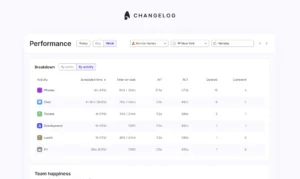
Scheduling to keep support teams happy

It’s not just about doing more with less or doing more with the same, the most important thing for agent-centric teams is to do more that keeps customers, managers and team members on the same side. Scheduling too often puts them on opposite sides.
Scheduling becomes imperative when your team starts having concerns about over or under-staffing. It’s equally crucial for gaining visibility to ensure that the team is consistently working on the right tasks at the right time, ultimately delivering delightful experiences for customers. This includes meeting service level agreements, maintaining high CSAT scores, and achieving a lower cost to serve through highly productive teams.
Understandably, agents get nervous when teams start implementing workforce management strategies or infrastructure changes, as it can potentially lead to reduced autonomy and flexibility in coordinating shifts. We’ve seen this first-hand, which is why we started building Surfboard – to build the first tool that puts managers and agents (surfers) on the same side.
Connecting tools that your support teams works in improves their confidence in management
Agents (or surfers) use a wide array of other tools outside of scheduling. This includes Google Calendar for scheduling 1:1s, tasks, wider team meetings or even personal appointments. A robust scheduling system provides visibility into these commitments, ensuring that your agents can effectively manage their work-life balance.
Why spreadsheets result in deteriorating morale
Spreadsheets, while widely used, come with limitations that can lead to a decline in team morale. Their generic nature, designed primarily for organising and analysing data of various kinds makes them less adaptable to sudden fluctuations in workforce levels.
When it comes to accounting for vacation time, spreadsheets lack the specialised functionality needed to effectively track overall vacation requests and previous decisions. This deficiency can result in unplanned work for the rest of the team and increased stress.
Moreover, ensuring a fair distribution of tasks becomes a daunting task within spreadsheets, as they lack the necessary oversight. These limitations can lead to frustration among team members, ultimately eroding morale.
Many workforce management systems don’t work for support teams that care about morale
Many workforce management systems heavily favour top down management styles, tend to be bloated with reporting features and often prioritise micromanagement over collaboration. The needs and collaborative nature that are often essential to maintain team spirit and reduce shrinkage are neglected or made very difficult to achieve with support teams that do not prioritise and actively foster team spirit.
Scheduling a team doesn’t mean micromanagement
As your team expands beyond 10 or 15 members, the operational landscape naturally becomes more complex. This evolution often involves the incorporation of new channels, adapting with BPOs, shifting from a generalist to a specialist model, or the expansion into different products or languages. These changes introduce varying work patterns, diverse skill sets, and the need to accommodate different time zones and shift preferences.
However, effective scheduling should not be synonymous with micromanagement. It’s not about hyper-focusing solely on daily KPIs of individuals. Instead, the focus should be on utilising data insights to identify knowledge gaps and areas where resource strategy needs to be refined to align more accurately with demand, optimise overall service levels, and continuously improve your team’s efficiency.
Moving from top down to collaborative scheduling
Different businesses have unique needs, and understanding what you’re looking for can make all the difference. Some companies may be deliberately seeking a tool for micromanagement, and if that sounds like your requirement, solutions like Calabrio, Assembled or Playvox might be the right for you.
These tools focus on giving you granular data including screen tracking to see exactly what agents are doing at any point in time. However, if you are looking for more collaborative software that builds equally for managers and agents, the right things to look for are:
- How much data is visible to agents? Is it solely manager-focused, or does it empower agents with insights into their performance?
- How much can agents self-serve and make requests in the product themselves?
- Does it provide any features that allow agents to provide feedback to managers like an eNPS tool?
- Is the team flexible when it comes to intraday tasks, ensuring that agents are scheduled for a variety of tasks beyond just responding to inbound requests?
- Does the tool accommodate flexible scheduling of shifts? Whether this is four-day work weeks, split shifts or part-time requests?
- How does the tool automate the distribution of working hours for less popular work windows? (e.g. weekends, evenings)
- How much does the tool integrate with the systems agents are already using as part of their daily workflow? Examples include Slack and calendar systems like Google Calendar
- What is the user experience for agents?
- How much does the tool foster a better experience for hybrid and remote agents?
By focusing on these factors, you can transition from traditional top-down scheduling to a more collaborative approach that empowers both managers and agents, ultimately leading to a more efficient and harmonious work environment.
Looking for more collaborative and simplified scheduling solution?
So, why wait? Dive into Surfboard and start riding the wave of success today. Your support team will thank you, and you’ll wonder how you ever lived without it. Discover how Surfboard can help you elevate your team’s morale, streamline scheduling, and create a happier work environment 🌊🏄♂️



